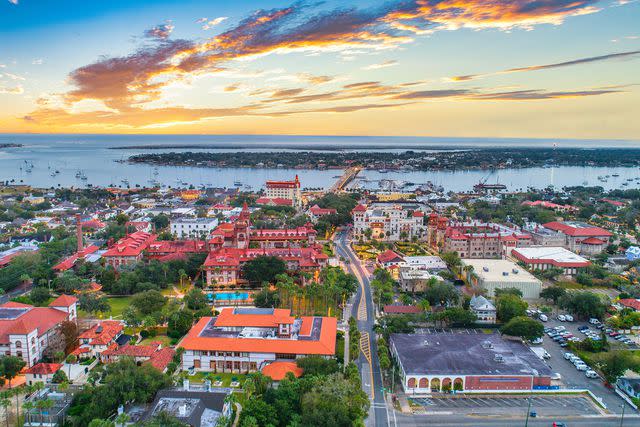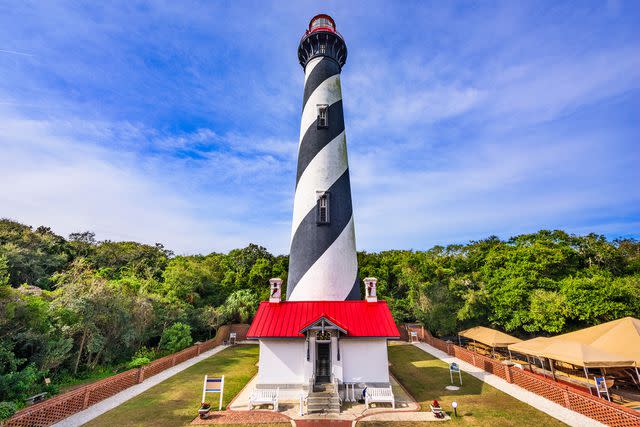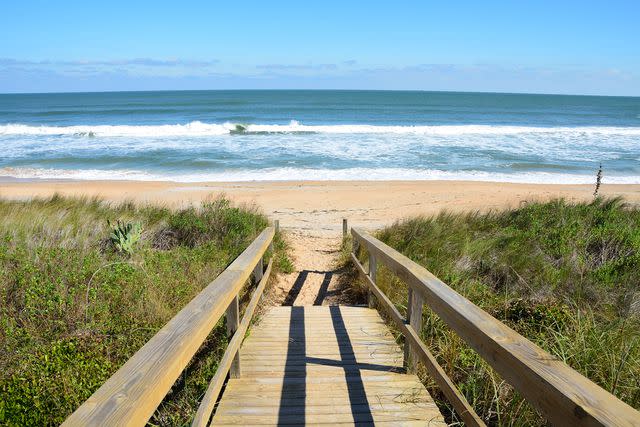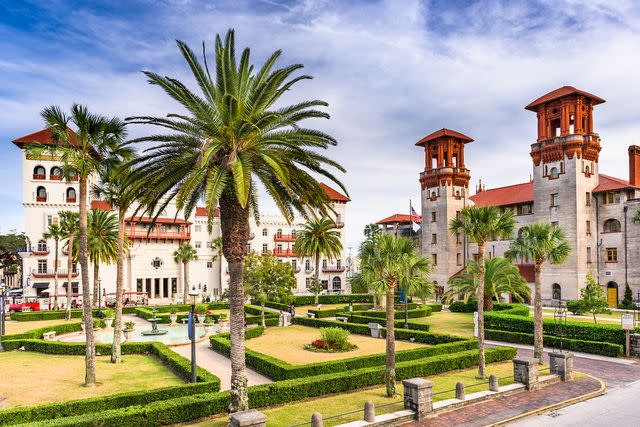This Charming Florida City Has Quaint Inns, Pristine Beaches, and Year-round Appeal
Here's what you need to know for a fun trip to St. Augustine, Florida.
Some Florida destinations are beloved for their white-sand beaches, while others are known for their history, food scene, or plentiful attractions. St. Augustine covers all those bases and more. This historic city is near the spot where Spanish explorer Juan Ponce de León, supposedly on a quest to find the fabled Fountain of Youth, landed in 1513. A permanent settlement was established a few decades later, making St. Augustine the oldest city in the mainland U.S. to be inhabited continuously since its establishment by European settlers.

Kruck20/Getty Images
Today, St. Augustine remains one of the most beautiful cities in Florida with tons of things to see, do, and explore. More than 450 years since its founding, St. Augustine remains one of the most beautiful cities in Florida. It's also a lively destination with tons of things to see, do, and explore.
Related: The 12 Best Places to Visit in Florida, According to a Lifelong Resident
Best Things to Do in St. Augustine

SeanPavonePhoto/Getty Images
While strolling the historic streets of St. Augustine is a worthwhile activity in and of itself, there are many ways to dig deeper beneath the surface of this spellbinding city.
A good way to start is by taking a trolley tour to get the lay of the land. Old Town Trolley Tours operate in seven historic cities across America, and on their St. Augustine tours, you’ll hear fascinating tales of the city’s past and present while hitting 21 hop-on, hop-off stops. The trolley passes by more than 100 points of interest around the city, including Ponce de León’s Fountain of Youth Archaeological Park, the Old Jail, the Oldest House Museum Complex, Ripley’s Believe It or Not!, and more.
Plus, you can return by night for the Ghosts & Gravestones iteration of the tour, filled with tales of the spooky, macabre, and paranormal. A “frightseeing” tour is a must in a city with ghosts as old as St. Augustine's.
Shopping in the historic district is another beloved activity. The pedestrian-only central thoroughfare, St. George Street, is loaded with shops, restaurants, attractions, funky boutiques, and antiquities. You can easily spend a day getting lost in and around this charming part of town.
As you wander, you won’t be able to miss the massive Castillo de San Marcos, a Spanish stone fortress dating back to the 1600s. Stop in for a tour, colonial history, and views of the St. Augustine Inlet.
For more historical eye candy, tour the stunning Flagler College and the Lightner Museum. Both were founded by Henry Flagler, a railroad magnate who spent many of his later years in St. Augustine — and they both have an architectural grandeur befitting Flagler's Gilded Age wealth. At Flagler College, you can admire the 79 (!) Tiffany stained-glass windows that illuminate the hand-painted murals adorning the university’s dining room, among other highlights. The Lightner, meanwhile, occupies the former Hotel Alcázar, making it a great place to see both an impressive art collection and the architecture of one of St. Augustine's first grand resorts.
Not into history? Outdoorsy types love St. Augustine’s beautiful Atlantic Ocean beaches, which aren’t far from the historic downtown. St. Augustine Beach and tranquil Crescent Beach are two favorites, complete with grassy dunes and windswept stretches of sand, but the protected wildlife sanctuary of Anastasia State Park is one of the area’s most peaceful destinations.
St. Augustine Hotels
In St. Augustine, boutique inns and historic hotels are the name of the game. There are chain hotels available in the area, which may be better for large groups or those on a strict budget, but for everyone else, staying in one of the city’s quaint inns is part of the fun. Best of all, the following properties are all located downtown, putting the whole of the historic district within easy walking distance.
The romantic St. Francis Inn on St. George Street is consistently popular among visitors and replete with historic charm. In addition to 19 elegant guest rooms and suites, the inn features a walled courtyard garden, swimming pool, bicycles, cozy living and dining rooms, and, of course, full gourmet breakfasts every morning.
Another favorite is The Collector Luxury Inn & Gardens, a charming, upscale property on Cordova Street at the edge of St. Augustine’s Old Town. The hotel is within walking distance of all the main attractions yet offers a peaceful getaway from the crowds. The inn offers modern yet plush rooms, in addition to shared spaces that include a stunning courtyard, cozy bar, and heated pool.
Another stunner you’re sure to spot on your visit to St. Augustine is the Casa Monica Resort & Spa, Autograph Collection. Built in 1888, this Moroccan-inspired property occupies a prime position in the heart of the historic district. A spa, event space, and an on-site Mediterranean restaurant are among its impressive amenities.
Other top-rated lodgings in St. Augustine include the Historic Sevilla House, Old Powder House Inn, Casa De Solana Bed and Breakfast, 44 Spanish Street Inn, and the Bayfront Marin House Historic Inn & Cottages, which is located across from Matanzas Bay (and is arguably the best waterfront hotel in St. Augustine) but also has off-property beach cottages and Caribbean-style homes on the ocean.
Best Times to Visit St. Augustine

Paulbr/Getty Images
There’s no bad time to visit St. Augustine. The city experiences more seasonal changes than many other parts of Florida since it’s located in the state’s north, but there are appealing reasons to visit year-round.
For thinner crowds in the historic district, go during the summer. There are disadvantages to this time of year — beaches will be crowded thanks to school breaks, and hurricanes can blow through and dampen plans — but, with few in-town visitors and lots of sunny days, it's undeniably a pleasant time for a trip. Springtime is also nice, with warm, breezy weather and lots of festivals.
In the fall, family tourism is minimal as school starts back up, so you might be able to snag some good prices and even enjoy some changing leaves (yes, St. Augustine is far enough north to have some colorful foliage). With mild weather, minimal rain and humidity, and fewer crowds, fall is the perfect time of year to stroll in the historic district, browse the many shops, and attend cultural festivals.
Another good time to visit is winter, thanks to the comfortable weather — temperatures rarely dip below 50 and are often as high as the low 70s — and Nights of Lights. From mid-November to the end of January, this award-winning festival lights up the city with more than three million lights. It's one of the top Christmastime attractions in Florida, so to avoid the crowds, try to time your visit outside of weekends and holidays.
Where to Eat and Drink
No matter where you eat, it’s hard to go wrong with a table in St. Augustine. The city one of the best foodie destinations in Florida, with restaurants that boast incredible ambience as well as mouthwatering food. St. Augustine is a great place to try typical Florida cuisine, like fresh seafood and Latin fare, but the historic-modern mix of eateries offers something for all to enjoy.
Ice Plant Bar, which presents farm-to-table food and craft cocktails in a renovated 1927 building, is located a little outside the historic district but is beloved by visitors. A1A Ale Works is another memorable spot. The second-floor restaurant and bar allows you to drink from a lengthy beer list while enjoying panoramic views of Matanzas Bay.
Other popular spots in St. Augustine’s historic district include The Floridian, which serves regionally inspired Southern fare; Columbia Restaurant, part of a Florida chain of Spanish eateries established in 1905; the New Orleans-inspired Harry’s Seafood, Bar & Grille (get a table in the stunning courtyard); Prohibition Kitchen gastropub; and Catch 27, which specializes in local seafood.
A little outside of the historic downtown, Gypsy Cab Company is a laid-back locals’ spot with a large and eclectic menu — and a peanut butter pie you will dream about forevermore.
Getting There

SeanPavonePhoto/Getty Images
Once you arrive in St. Augustine, transportation is easy: you basically don't need any beyond your own two feet. The historic district is designed to be pedestrian-friendly, and the narrow streets can make car travel more trouble than it's worth (if it's even allowed — some streets forbid cars altogether). Trolleys connect the city if you need to cover lots of ground, but most of the best spots are easily reachable on foot.
To get to the city, though, a car — or a lengthy taxi or Uber ride — will probably be required. The closest major airports are Jacksonville International (JAX) to the north and Daytona Beach International (DAB) to the south, and both are about an hour's drive away. Northeast Florida Regional Airport (UST) is only 10 minutes from the historic district, but it serves only private planes.
If you plan to drive to St. Augustine, you can do so easily via Interstate 95, U.S. Highway 1, and scenic Florida Highway A1A. These routes all approach St. Augustine from both north and south, making it easy to get here from a number of major cities in the region. Orlando is about two hours away, and Savannah, Georgia, is about three hours away.
For more Travel & Leisure news, make sure to sign up for our newsletter!
Read the original article on Travel & Leisure.

